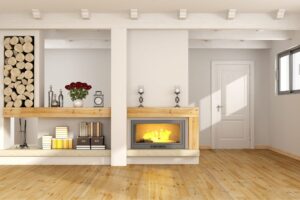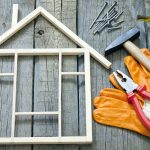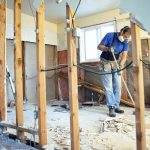From ancient to modern times, fireplaces have been functional and aesthetic centerpieces in homes. Initially, they provided warmth and a place to cook. Today, the design and installation of a fireplace may transform an ordinary room into a cozy haven. However, framing a fireplace is crucial to its overall appearance and function.
Whether you’re integrating a fireplace insert into an existing fireplace or setting up an electric fireplace, it’s essential to understand the basics of fireplace framing.
This guide will simplify the DIY electric fireplace installation process and highlight crucial considerations before starting your project.
What To Do Before Framing Fireplace
Purpose & Function
Heat source vs. aesthetic appeal: While many opt for electric fireplaces purely for their visual charm, others look for a genuine heat source. So, be sure of your primary motive to guide the type and design of your fireplace.
Traditional wood-burning vs. gas vs. electric fireplace: Each type has pros and cons. Electric fireplaces, for instance, offer ease of installation and are the top choice of DIY enthusiasts.
Local Building Codes & Regulations
Safety requirements: Before diving into your DIY electric fireplace project, it’s paramount to understand and comply with local safety regulations to ensure the well-being of inhabitants.
Emission standards: While electric fireplaces don’t emit fumes, consider local emission requirements for a wood or gas option.
Placement & Space Planning
Ensuring proper ventilation and clearance: Electric fireplaces might not require chimneys but need clearance for safety and aesthetics.
Centerpiece vs. corner designs: The layout of your room and your aesthetic preference will determine the placement of your fireplace.
Budget Considerations
Cost differences among various materials and fireplace types: For instance, an electric fireplace might have a different initial cost than a wood-burning one. However, the long-term maintenance and energy costs can vary.
Hidden costs: Don’t forget the potential expenses for permits, inspection fees, or any modifications to your existing fireplace structure.
Choosing the Right Fireplace Insert
Electric vs. wood vs. gas: An insert may transform an existing fireplace or be part of a new installation. Hence, understand the specifications and requirements of the insert, especially if it’s for an electric fireplace.
Matching the insert with the fireplace surround: The harmony between the insert and its surround plays a crucial role in the overall aesthetic appeal.
Basics of Fireplace Framing
Materials & Tools
Recommended types of wood: Choosing non-combustible materials is crucial for fireplace framing, especially around a gas fireplace. If you prefer wood framing, make sure it’s adequately shielded from the fireplace’s heat source.
Necessary tools: Keep a reliable set of wood screws, a drill, a saw, a level, and safety gear like gloves and goggles handy.
Additional materials: For areas closest to the heat, cement board is more suitable than traditional drywall due to its heat-resistant properties.
Step-by-Step Framing Process

Measuring and Marking
Determine the dimensions of your fireplace, including height, width, and depth. This helps your frame fit snugly around a traditional fireplace or modern gas fireplace insert.
Constructing the Primary Frame
Start with the fireplace base, ensuring it’s level and secure. This is usually a horizontal piece bearing much of the structure’s weight. Vertical supports are then attached to this base.
Adding support beams and cross-members provides stability, especially for more expansive fireplaces. Also, use wood screws to secure each piece, to boost tight connections without gaps.
Prepping for Fireplace Inserts
If you’re incorporating a space heater or a gas fireplace, insert it into an old fireplace and keep enough space and support within the framing.
Common Pitfalls & Solutions
Avoiding weak joints: Make all corner seams well-joined and reinforced. This not only guarantees safety but also ensures the frame remains square.
Keep even weight distribution: Uneven weight can cause tilting or even collapse. So, create a robust fireplace base and support and spread the weight adequately.
Advanced Fireplace Framing Techniques
Incorporating Built-In Shelves or Cabinetry
When adding shelves, think about the weight they’ll bear. Also, reinforce with extra wood framing or supports as needed.
Given the heat from the fireplace, choose materials for the cabinetry or shelves that won’t warp or discolor.
Designing for Multi-Sided Fireplaces
Multi-sided or see-through fireplaces offer a view from multiple rooms. Make sure the framing doesn’t obstruct the view while still being sturdy.
Such designs may distribute heat differently. So, factor this into your framing decisions to prevent any damage to the wood framing.
Creating Archways or Special Design Features
These can be more challenging due to the intricacies of cutting and joining. Consider using flexible materials or specialized tools.
If you’re updating or renovating an old fireplace, make sure the new design elements or features blend seamlessly with the overall aesthetic.
Finishing Touches
Choosing Suitable Materials
While drywall is commonly used for the surrounding wall areas, it is preferred closer to the fireplace because of its heat-resistant properties.
On the other hand, brick offers a classic, rustic appeal, while stone or tile can provide a more modern or elegant look. Remember, if you’re updating an older fireplace, ensure your chosen material complements the existing aesthetic of the room.
Installation of a Fireplace Mantel
While standard designs might be more cost-effective, a custom-made mantel can become a valid focal point of a room. However, it comes at an extra cost.
Before affixing the mantel, make the wall lightly sanded and cleaned for a smooth application. Note that cleaning and organization are essential to getting this right.
Safety Precautions Post-Framing
Safety barriers can prevent fire hazards, especially when wood framing is close to the fireplace. Like any other built-in feature in your house, your fireplace and frame need regular checks to promote longevity and safety.
Enhancing the Aesthetic Appeal
Decor Ideas for Above the Fireplace
Choose a final piece that accentuates the room’s design and elevates the fireplace as a focal point. Note that incorporating built-ins or shelves on either side of the fireplace provides functionality and a symmetrical, polished look.
Accessorizing the Hearth
Beyond functionality, accessories like fireplace screens, grates, and tools can complement the room’s design- whether modern, rustic, or classic.
Seasonal Decorations & Themes
Depending on the season or holiday, consider introducing pops of color. You achieve this with paint, accessories, or temporary decorations, making the fireplace area ever-evolving and fresh.
Summary
The process of framing a fireplace requires meticulous attention to both structure and design. From the initial wood framing to the final decorative touches, every detail matters in remodeling a simple fireplace into the heart of a room.
Whether introducing built-ins, experimenting with brick or paint, or focusing on the frame, the goal remains: creating a stunning focal point. Particularly one that complements the house’s design while offering warmth and comfort.
With the right approach and commitment, a fireplace can be more than just a functional element—it can be the soul of a home.



